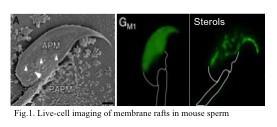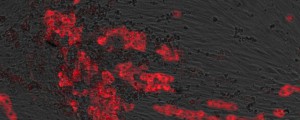Research goals
“Reproduction” is a profound process that consists of sequential events occurring at different temporal and spatial scales. How are the complex mechanisms regulated? Motivating to resolve the question, researches in our laboratory are focused on understanding of cellular and molecular basis for fertilization and development in mammals. The resultant data should be useful for promoting translation between research and developing practical applications that benefit both human and animals.

1) Functions of membrane rafts in fertilization
Membrane rafts are dynamic membrane regions enriched in sterols, ganglioside GM1 and functional membrane proteins. They play an important role in several cellular functions in different cell types.  Recently, our experiments in mouse sperm demonstrated that membrane rafts are present in the acrosomal plasma membranes [APM (Fig.1)] and play important role in membrane fusion that occurs later (known as acrosome exocytosis). These suggested to us that membrane rafts play a role in fertilization. Now we expand our research into other species with different fertilization system to test our hypothesis.
Recently, our experiments in mouse sperm demonstrated that membrane rafts are present in the acrosomal plasma membranes [APM (Fig.1)] and play important role in membrane fusion that occurs later (known as acrosome exocytosis). These suggested to us that membrane rafts play a role in fertilization. Now we expand our research into other species with different fertilization system to test our hypothesis.
2) Mechanisms for sperm functional maturation during epididymal passage
After leaving the testis, sperm undergo functional maturation in the epididymis by selectively acquiring lipids and proteins, which are important extra-cellular factors for fertilization. However, very little is known about the mechanisms involved in the selective acquirement of these molecules during the epididymal transit of sperm. This led us to investigate the mechanisms underlying epididymal maturation, using boar sperm.

3) Development of stem cell-based technologies for preservation and production of animals
Induced pluripotent stem (iPS) cells are undifferentiated cells, which are artificially induced by transducing the reprogramming factors. In experimental animals, it has been shown that iPS cells were able to differentiate into specific cells and generate organs or even animals. Additionally, recent studies reported successful generation of iPS cells from specific cells obtained from endangered species. Together, these reports led us to investigate molecular mechanisms involved in the reprogramming of s omatic cells to iPS cells. The results will be useful for generating technologies to rescue animals which have become endangered or already are extinct.
omatic cells to iPS cells. The results will be useful for generating technologies to rescue animals which have become endangered or already are extinct.
If you are interested in our researches, please feel free to contact with me.
Contact
Atsushi Asano, PhD
University of Tsukuba
Faculty of Life and Environmental Sciences
1-1-1 Tennodai, Tsukuba, Ibaraki 305-8577 JAPAN
Email: asano.atsushi.ft(AT mark)u.tsukuba.ac.jp
Tell: + 29-853-6691
